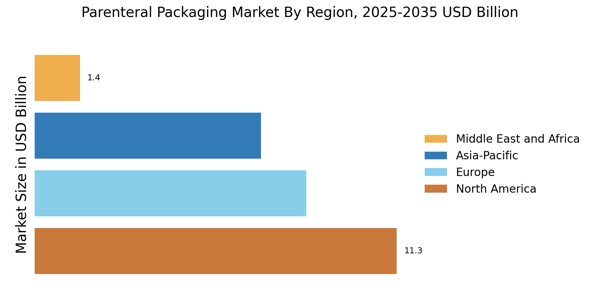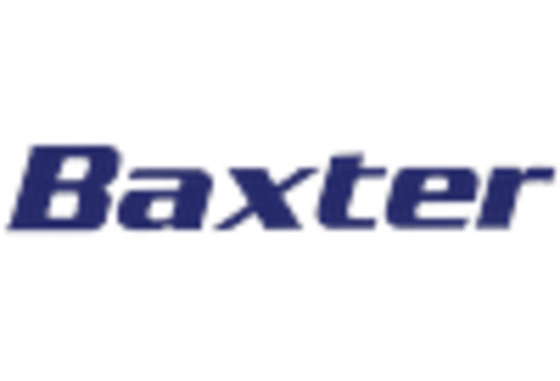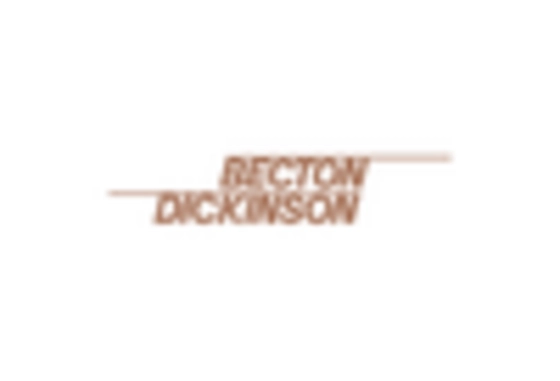Rising Demand for Biologics
The increasing prevalence of chronic diseases and the aging population are driving the demand for biologics, which require specialized parenteral packaging solutions. The Parenteral Packaging Market is witnessing a surge in the development of biologics, with a projected growth rate of approximately 8% annually. This trend necessitates advanced packaging that ensures the stability and efficacy of these sensitive products. As biologics often come in liquid form, the need for high-quality vials, syringes, and other parenteral packaging formats is paramount. Furthermore, the complexity of biologics, including monoclonal antibodies and gene therapies, demands innovative packaging solutions that can accommodate their unique storage and handling requirements. Thus, the rising demand for biologics is a significant driver for the Parenteral Packaging Market.
Growth of Home Healthcare Services
The expansion of home healthcare services is significantly impacting the Parenteral Packaging Market. As more patients receive treatments at home, the demand for user-friendly and safe parenteral packaging solutions is increasing. This trend is particularly evident in the rise of self-administration of medications, which requires packaging that is not only convenient but also ensures safety and efficacy. The market for home healthcare is expected to grow at a compound annual growth rate of around 9%, further driving the need for innovative packaging solutions. Manufacturers are responding by developing packaging that facilitates easy handling and administration, thereby enhancing patient compliance. Consequently, the growth of home healthcare services is a vital driver for the Parenteral Packaging Market.
Increasing Focus on Sustainability
Sustainability is becoming a critical consideration in the Parenteral Packaging Market, as manufacturers seek to reduce their environmental footprint. The demand for eco-friendly packaging materials, such as biodegradable plastics and recyclable options, is on the rise. This shift is driven by both regulatory pressures and consumer preferences for sustainable products. Companies are increasingly investing in research and development to create packaging solutions that minimize waste and promote recycling. The market for sustainable parenteral packaging is projected to expand, with estimates indicating a growth rate of approximately 7% annually. As organizations strive to meet sustainability goals, the Parenteral Packaging Market is likely to see a transformation in packaging practices, aligning with broader environmental initiatives.
Technological Innovations in Packaging
Technological advancements are reshaping the Parenteral Packaging Market, leading to the development of more efficient and safer packaging solutions. Innovations such as prefilled syringes, which enhance convenience and reduce the risk of contamination, are gaining popularity among healthcare providers. The market for prefilled syringes is expected to grow significantly, with estimates suggesting a compound annual growth rate of around 10% over the next few years. Additionally, the integration of smart technologies, such as RFID and IoT, is enhancing supply chain management and product tracking. These technologies not only improve operational efficiency but also ensure that the integrity of parenteral products is maintained throughout their lifecycle. Consequently, technological innovations are a key driver of growth in the Parenteral Packaging Market.
Regulatory Compliance and Safety Standards
The Parenteral Packaging Market is heavily influenced by stringent regulatory requirements aimed at ensuring patient safety and product integrity. Regulatory bodies, such as the FDA and EMA, impose rigorous standards for packaging materials and processes. Compliance with these regulations is essential for manufacturers to avoid costly recalls and legal issues. The increasing focus on safety has led to the adoption of tamper-evident and child-resistant packaging solutions, which are becoming standard in the industry. Additionally, the need for traceability and serialization in packaging is gaining traction, driven by regulations aimed at combating counterfeit drugs. As a result, companies are investing in advanced packaging technologies that meet these regulatory demands, thereby propelling the growth of the Parenteral Packaging Market.


















Leave a Comment